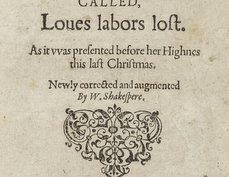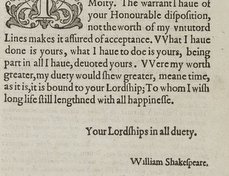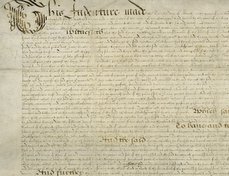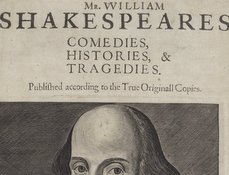In March 1613 “William Shakespeare of Stratford vpon Avon in the countie of Warrwick” and three associates agreed to purchase the Gatehouse of the former Dominican priory in London known as “Blackfriars” for the sum of £140. The indenture of bargain and sale is dated March 10. The same group agreed to a mortgage, dated March 11, for the property in the amount of £60, implying that the buyers put up only £80 at the time of sale.
The vendor of the property was Henry Walker, citizen and minstrel of London, resident of the parish of St. Martin Ludgate. (The Mr. Henry Walker, a resident of Stratford-upon-Avon, mentioned in the will of John Combe probated in 1615, was a different individual.) The purchasers of the property were William Shakespeare; William Johnson, citizen and vintner of London; John Jackson, gentleman; and John Heminges, gentleman. Shakespeare was the true purchaser of the Gatehouse, while Johnson, Jackson, and Heminges served merely as his trustees. Johnson was landlord of the Mermaid; Jackson was possibly a shipping magnate from Yorkshire; Heminges was one of Shakespeare’s fellows in the company of players known as the King’s Men, as confirmed by his signature on the transfer of the Gatehouse in 1618. The indenture of bargain and sale and the indenture of mortgage were probably both signed on March 11. Later that same day Walker went to the Rolls Office in Chancery Lane where he arranged for a copy of the indenture of bargain and sale to be enrolled.
According to the description of the property in the indenture of bargain and sale, the Gatehouse was adjacent to the King’s Wardrobe on the east side and to a plot of ground belonging to the widow Anne Bacon on the west. The third side of the property was a brick wall that faced a street leading down to Puddle Wharf on the Thames. Purchase of the property included free entry through the gate and the yard, and access to “all and singular cellars, sollars [i.e., attics], rooms, lights, easements, profits, commodities, and hereditaments whatsoever to the said dwelling house or tenement belonging, or in any wise appertaining.” While the possibility cannot be excluded that Shakespeare reserved some odd corner of the property as a pied à terre for easy access to his company’s Blackfriars playhouse, a more reasonable supposition, given that the property was traditionally occupied by tenants, is that the Gatehouse was a financial investment rather than a residence for any of its owners.
The two indentures of bargain and sale from the 1613 Gatehouse purchase have each confusingly been called the “conveyance” or the “counterpart.” The two copies were originally one document, written head-to-head on one large sheet of parchment. After each part was sealed and signed, the two parts were separated by a long, wavy cut. Accordingly, if the two copies could be brought together even today, as they have been photographically, their wavy lines would mate precisely. The copy signed by the vendor (Walker) was to be kept by the buyers (Shakespeare and his trustees), and the copy signed by buyers was to be kept by the vendor.
However, when Walker went to the Rolls Office to have the text of the indenture of bargain and sale copied onto a Close Roll, he deposited the copy ultimately intended for Shakespeare. After this enrollment was completed on April 23, office clerks noted the enrollment on two contemporary Indexes to the Rolls. In one index, to grantees, the transaction is listed three times, under the surnames Jackson and Johnson; Heminges; and Shakespeare. In the other index, to grantors, it is listed under the surname Walker.
Exactly when the mortgage was paid, and the property purchased in full, is a matter of disagreement among Shakespeare biographers. Most claim that the £60 was not paid until after Shakespeare’s death, and that it was paid by his son-in-law John Hall. But surviving documents relating to the Gatehouse make no further mention of Walker, suggesting that Shakespeare met the deadline, which was September 29, 1613. The Blackfriars property is mentioned in many subsequent documents. In 1615 Shakespeare joined Bendish v. Bacon, an apparently friendly lawsuit initiated by Blackfriars property owners to secure “letters patentes and other deeds.” Shakespeare’s will of 1616 mentions “All that Messuage or tenemente with thappurtenances wherein one John Robinson dwelleth, scituat, lyeing and being in the blackfriers in London nere the Wardrobe.” John Robinson was only the most recent tenant of the Gatehouse. Previous tenants, under earlier owners, included James Gardyner esq., John Fortescue gent., and William Ireland.
On February 10, 1618, five years after the initial sale, the three trustees Johnson, Jackson, and Heminges “sold” the Gatehouse to two new trustees, John Greene of Clement’s Inn, London, brother of Thomas Greene, the Stratford town clerk; and Matthew Morrys of Stratford-upon-Avon. The stipulated price of 5 shillings compared to the £140 price in 1613 indicates that this was not a true sale, but rather a simple a transfer of title. The explicit purpose of the 1618 transfer was to secure the property to Shakespeare’s daughter Susanna, wife of Dr. John Hall. In the case of Susanna’s demise the property would go to any of her male heirs; then to male heirs of her sister Judith (Quiney); and in the case of Judith’s demise, to any male heir of William Shakespeare whatsoever. Technical issues with inheritance of the property in the absence of male heirs resulted in new documents as late as 1647.
Of the surviving documents associated with Shakespeare’s purchase of the Blackfriars Gatehouse, four indentures — three from 1613 and one from 1618 — contain many names, signatures, and seals. It is a matter of almost incredible good fortune that these documents preserve two Shakespeare signatures and one signature of his fellow player John Heminges.
Henry Walker’s signature, which occurs only once among surviving documents, is unproblematic. The signatures of William Johnson and John Jackson are consistent over three documents, including the 1618 indenture – although the elaborateness of John Jackson’s J’s varies. John Heminges’ signature from 1618 matches his signature in the archives of his parish church of St Mary Aldermanbury.
The 1613 indenture of bargain and sale and the indenture of mortgage, both signed by three buyers, preserve two of six surviving Shakespeare signatures. (The Bellott v. Mountjoy Deposition of 1612 preserves one signature, while Shakespeare’s will of 1616 is signed on each of its three leaves.) Shakespeare’s two signatures on the 1613 indentures differ slightly from one another, though probably written at the same sitting on March 11, 1613, in London. On the indenture of bargain and sale, his signature is written on two lines: “William” is written out, and the signature generally conforms to that of his Bellott v. Mountjoy Deposition, especially in the placement of the “dot” in the loop of the majuscule “W.” On the indenture of mortgage, the signature is written on one line: the forename is abbreviated to “Wm”; the medial “s” in the surname is the identical spidery stroke. Shakespeare’s surname is naturally more compressed on the mortgage, where he attempted to sign his entire name on one line, than on the indenture, where he wrote his forename and surname on two separate lines. It is evident from a comparison of all six surviving signatures that Shakespeare varied his signatures according to circumstances. The two 1613 signatures reflect two different ways of coping with the narrow widths of parchment tags. (For a third way, see the two signatures of John Jackson.)
For the indenture of bargain and sale and the indenture of mortgage, William Shakespeare and William Johnson “borrowed” the seal of Henry Lawrence, servant of the scrivener Robert Andrewes. Although seals might still be used at this date for their original purpose of verifying the identity of a signatory, the seal loaned by Henry Lawrence served merely to secure the parchment tags. Here, personal signatures clearly took precedence over their seals as evidence of identity.
The three surviving indentures from March 1613 all carry an essentially identical endorsement:
Sealed and deliuered … in the presence of
(signed) Will: Atkinson
(signed) Robert Andrewes Scrivener
(signed) Henry Lawrence servant to the same Scrivener
(signed) Ed: Ouery
The endorsements of the two documents signed by Shakespeare and his associates add “by the said William Shakespeare, William Johnson, and John Jackson” after “sealed and delivered.” Had it survived, the copy of the indenture of mortgage signed by Henry Walker would doubtless have carried the same endorsement as the copy of the indenture of bargain and sale signed by him.
Literary scholar Leslie Hotson has identified all four witnesses for the 1613 transactions. Robert Andrewes and Henry Lawrence identify themselves as scriveners, while Edward Overy is known from other documents as yet another scrivener. William Atkinson, gentleman, of the parish of St. Mary Aldermanbury, was a clerk of the London Company of Brewers. Gregory Donhault, a witness to the enrollment of the indenture of bargain and sale, was one of twelve Masters in Chancery, and a member of the same parish.
Two of the witnesses may have represented Henry Walker’s interests, two the interests of William Shakespeare. As Walker would later make Edward Overy one of two executors of his will (TNA PROB 11/128/230), it is likely that Overy and Atkinson represented Walker, while Andrews and Lawrence (master and servant) represented Shakespeare. This supposition is consistent with the fact that Lawrence impressed his own seal-ring on the seals which secured the labels and signatures of Shakespeare and Johnson.
All three surviving indentures from the 1613 transaction are written in the hand of Henry Lawrence, as may be verified by comparing the “ff” and “L” of his endorsements and signatures with the same letters in the documents. The lost copy of the indenture of mortgage, which would have carried Henry Walker’s signature and seal, was presumably also written by Lawrence. The enrolled copy and the associated note on the dorse of the indenture of bargain and sale were written by Richard Bull. All signatures, including that of Gregory Donhault, are original; none of the signatories signed with a mark.
Documents
Indenture of bargain and sale: March 10-11, 1613
Copy signed by Henry Walker: Folger Shakespeare Library, Z.c.22(45)
Copy signed by William Shakespeare and trustees: London Metropolitan Archives, CLC/522/MS03738
Enrolled copy: The National Archives, C 54/2184 (no. 45)
Index to Grantees: The National Archives, C 275/30, page 536
Index to Grantors: The National Archives, C 275/94, folio 45 recto
Indenture of mortgage: March 11, 1613
Copy signed by Shakespeare and trustees: British Library, MS Egerton 1787
Bendish v. Bacon: 1615
Lawsuit: The National Archives, C 2/JasI/B11/9 (2 parts)
The National Archives, C 33/127, folio 1074 recto
Indenture of bargain and sale: February 10, 1618
Copy signed by Johnson, Jackson, and Heminges: Folger Shakespeare Library, Z.c.22(44)
Property Inheritance
Shakespeare Birthplace Trust, ER1/1/107
Shakespeare Birthplace Trust, TR46/1/10
Shakespeare Birthplace Trust, TR46/2/8
Co-written by Alan H. Nelson and Folger Shakespeare Library staff
Sources
James Orchard Halliwell-Phillips, Outlines (1887): 1:238-40, 2:37-41.
James Orchard Halliwell-Phillips, Outlines (1889): 2:37-41.
E.K. Chambers, William Shakespeare: a Study of Facts and Problems (1930): 2:154-9, 168.
J. Leslie Hotson, Shakespeare’s Sonnets Dated, and Other Essays (1949).
B. Rowland Lewis, Shakespeare Documents: 2:435-48, 467-71, 531-4.
Samuel Schoenbaum, William Shakespeare: A Documentary Life: 220-6.
Samuel Schoenbaum, William Shakespeare: Records and Images: 39-48.
Robert Bearman, Shakespeare's Money (Oxford: Oxford University Press, 2016): 166-71.









